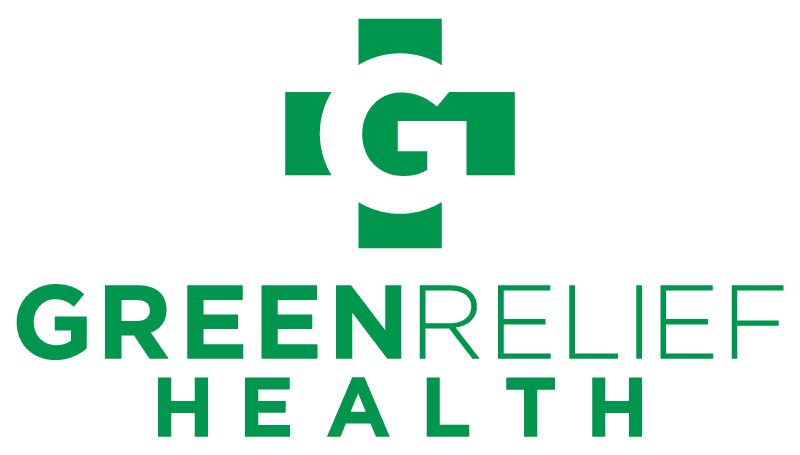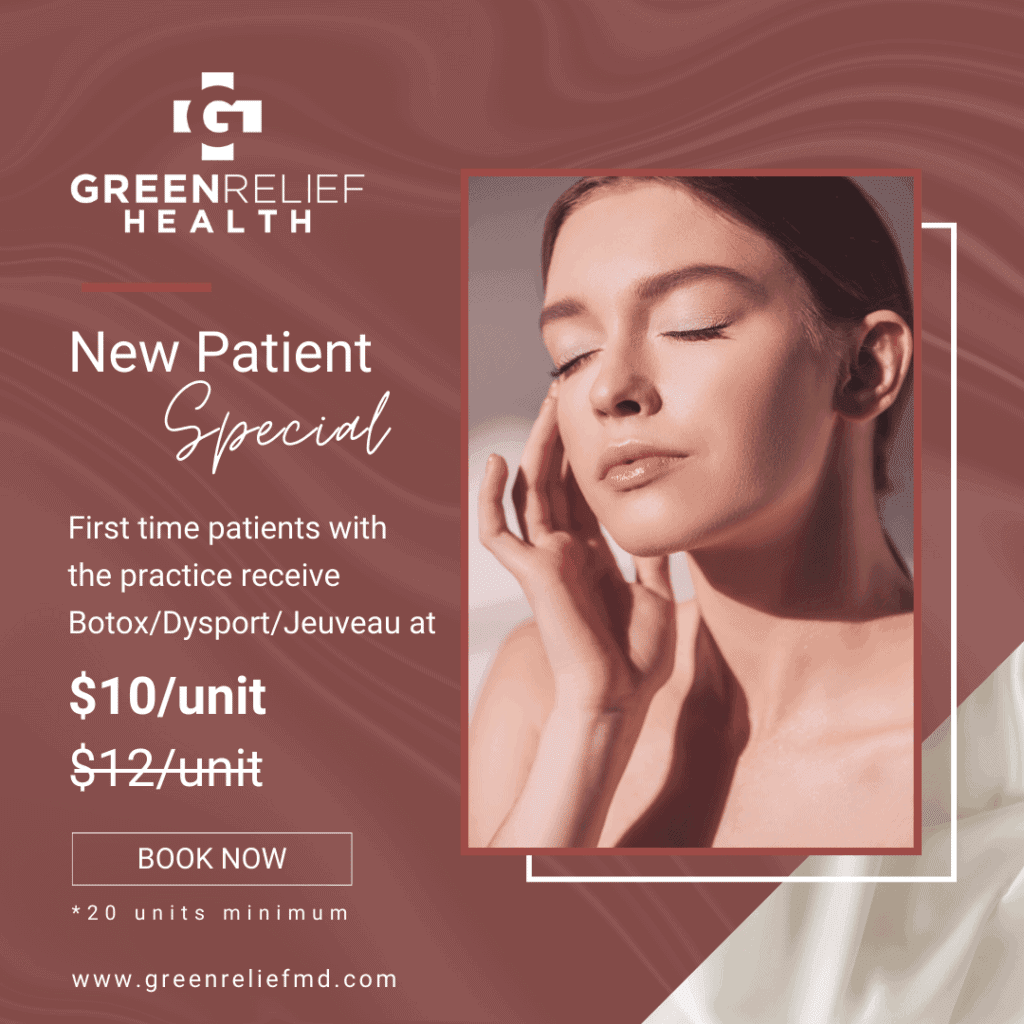Do you find yourself interested in ways to reduce wrinkles but aren’t sure what the difference is between Botox and Dysport? Don’t worry; you are not alone when trying to understand these two different neuromodulators.
Getting wrinkles is something we all have to deal with. Despite the fact that we can’t stop time or reverse the aging process, injectables can help you regain a more youthful appearance.
Green Relief Health, located in Baltimore, Maryland, offers injectables to help smooth unwanted fine lines and wrinkles.
Botox is one of the most popular injectables, but it’s not the only one. As a result of its effectiveness in treating wrinkles and fine lines, Dysport has gained a lot of popularity. This article compares and contrasts the two so that you can choose which is right for you.
Similar In Nature
While there are definite differences between Botox and Dysport, there are also many similarities. The main similarity is that they are both neuromodulators. This means that they work by disrupting nerve signals to your muscles, which in turn relaxes the muscles.
Botox and Dysport are both made from botulinum toxin, a neurotoxic protein that is safe in small amounts. Although you can use Botox and Dysport to improve various medical conditions, their most popular use is to diminish wrinkles.
The differences lie in the trace proteins and production methods of these two products. Let’s explore the differences below by exploring each product.
Botox Difference From Dysport
The primary ingredient for Botox is a purified form of botulinum type A. As previously mentioned, this is a neurotoxin or neuromodulator that blocks the transmission of neurotransmitters associated with muscle movement.
As compared to other neurotoxin injectables, the composition of this injection is concentrated and thicker. Botox remains in one area without spreading until the ingredients are naturally metabolized by the body. Botox has this advantage, especially for those with severe wrinkles.
Botox Areas of Treatment
In various areas of the face, Botox is used to treat moderate to severe wrinkles. These areas include forehead wrinkle lines, lateral canthal lines, otherwise known as “crow’s feet,” and glabellar lines, which are commonly known as the frown lines or the “elevens.”
While there are many other areas of the face that Botox can be used on, these are the most common areas of injection for patients looking to relax their wrinkles and achieve smoother skin.
Are There Any Differences in the Treatment Procedure?
Botox and Dysport are renowned treatments for those desiring to diminish facial wrinkles, such as forehead lines, smile lines, and the vertical lines found between the eyebrows. These treatments employ the bacterium Clostridium botulinum.
When introduced into the body, it temporarily immobilizes facial muscles, thus reducing the prominence of wrinkles.
Diving deeper into their differences, while both Botox and Dysport leverage botulinum toxin type A as their primary active ingredient, the surrounding accessory proteins are not identical. Dysport possesses fewer accessory proteins, which some believe might be attributed to its quicker cosmetic effect onset.
Additionally, the unit measurement differs between the two treatments; Dysport often demands 2-3 times the number of units compared to Botox for the same effective results. However, this doesn’t necessarily suggest that Dysport is weaker or less effective than Botox.
Feedback from some users indicates that Dysport might present visible results a bit faster after the injection, often within 2-3 days, compared to Botox, which might take 3-4 days.
That said, the longevity of their effects is relatively similar, though, as with any cosmetic treatment, the outcomes can be subjective and vary from person to person.
Another distinguishing characteristic is Dysport’s propensity to disperse over a more extensive region from the injection point. This spreading can be advantageous when treating more significant areas, but it does demand a meticulous touch from the administering practitioner to ensure accuracy and the desired outcome.
From a corporate standpoint, two different pharmaceutical giants produce these treatments. Botox is a product of Allergan, while Galderma is responsible for Dysport.
Regarding the administration of these treatments, both are delivered directly into designated facial muscles via a fine needle.
The process is generally well-tolerated, but some patients might experience minor discomfort or pain. To alleviate these sensations, a topical anesthetic can be applied prior to the procedure. Beyond their aesthetic applications, it’s worth noting that these treatments also offer therapeutic benefits.
When Can I Expect To See Results
When you are looking to treat your wrinkles with Botox, you might ask if results are instantaneous and seen as soon as your provider injects you or if results might take a few days to a few weeks to see results.
The answer to this question can vary; however, for most patients, Botox results start to show up after about 4-5 days.
It is important to note that while you will start seeing your wrinkles relax a few days after injection, you will not see the full or peak results from treatment until at least 2-3 weeks after injection.
While it can be exciting to start seeing changes in your skin after your Botox injection, you should not anticipate having full results until the 2–3-week timeframe.
How Long Will Botox Last
Another common question you might be wondering is how long Botox will last in your body or when you can expect to start to see your treatment results fade. This is variable per patient and dependent on a few factors.
These factors include your gender, your intrinsic metabolic rate, how physically active you are, how long you have been receiving Botox treatments, and lastly, the dose you receive during your treatment. On average, Botox will last about three months, and patients will require retreatment around the 3-month timeframe.
It is important to find a provider who is confident in treating you and explains the expected outcome and length of treatment. You also need to trust their guidance on dosing.
How Much Botox Do I Need?
This is a common question among patients and, again, is a patient variable answer. This is not a “cookie cutter” response and despite the FDA’s approval of certain units for dosing in each of the areas previously discussed, such as the crow’s feet, forehead, or glabellar lines, your provider will review your individual facial anatomy and muscle structure to determine your appropriate dosing.
Sometimes, it might seem like the lesser dose, the better due to cost or worry about your dose being too high; however, finding a trusted Botox injector is key in making sure you are receiving adequate dosing and the highest standards of care in the practice of aesthetic medicine.
The recommended and approved dosing of forehead wrinkles is 20 units, for the glabellar area is also 20 units, and for the crow’s feet wrinkles, a total dose of 24 units, or 12 units per side. This is a total of 62 units for the three areas.
Receiving Botox treatment is a medical procedure, and it is not recommended to negotiate dosing with your provider to ensure consistent, adequate, and long-lasting results.
Dysport Difference From Botox
The primary ingredient for Dysport is another form of botulinum type A. Like Botox, Dysport is another very popular and commonly used neurotoxin that blocks the transmission of the neurotransmitters associated with muscle movement.
This injectable’s composition varies from Botox due to the size of the protein, the lower molecular weight of the product, and the spread or dilution of the product being larger when injected into the face.
When injecting neurotoxins, location and precision are critical. This makes it a particularly good option for areas such as the forehead or glabellar region where more spread is acceptable. Another factor or difference is that due to the size of the protein, your body may have a lesser chance of developing antibody resistance against the medication.
Dysport Areas of Treatment
While Dysport is FDA-approved for the frown lines or glabellar lines in the face, it is also commonly administered in the forehead and “crow’s feet” areas to treat moderate to severe wrinkles.
Are There Any Side Effects of Botox and Dysport Treatment?
Botox and Dysport are commonly used to minimize facial wrinkles, such as those on the forehead and around the eyes. By targeting facial muscles, these injections work to reduce muscle activity, which in turn diminishes wrinkles. However, like many medical procedures, they can come with certain side effects.
It’s not uncommon for individuals to feel a bit of discomfort at the injection point or even a minor ache for a few hours post-procedure. Some might also find the muscles in the injected region or nearby feeling a tad weaker. Thankfully, these symptoms often disappear within a few days.
Besides the aforementioned, some might notice short-lived reactions like swelling, a touch of bruising, or redness where the injection was administered. More severe reactions, while extremely rare, can include issues like respiratory complications, discomfort in the neck, or a persistent sore throat.
Any signs suggesting an extreme reaction to the botulinum toxin, such as problems with swallowing or breathing, warrant immediate medical care.
Considering Botox and Dysport have unique formulations, particularly in their protein content and the concentration of botulinum toxin type A, people might react differently to each.
Though widely recognized as safe, the potential for side effects or allergic reactions makes it crucial to get these injections from certified experts.
For those pondering over such treatments, scheduling a preliminary meeting with a certified expert is advisable. This gives them a chance to outline their aesthetic desires, understand the possible risks, and chart out a suitable course of treatment.
Furthermore, it’s an apt time to inform the expert about ongoing medications or existing health conditions that might affect the procedure or its aftermath.
Do Dysport and Botox Have the Same Length of Treatment
Now that you have read about the onset of action and duration to see the peak effect from Botox injections, we will talk about Dysport and how long you can expect to start seeing the effect of this medication.
Dysport can start showing signs of effects quicker than Botox, generally around 3-4 days rather than 4-5 days like Botox. However, Dysport, similarly to Botox, still takes about 2-3 weeks to see full or peak effect from that dosing and treatment.
Another difference between Botox and Dysport is the duration of treatment. Dysport may last for you up to 6 months, unlike 3-4 months for Botox.
It is important to note, however, that the same factors that can affect the duration of your treatment with Botox occur with Dysport. Patients with high metabolic activity, who are physically active, and who have a history of requiring more frequent treatment with neurotoxins can expect to have a duration of treatment of around 3 to 4 months for Dysport as well.
Dysport Dosing
Just like the dosing of your Botox treatment, Dysport is dependent on a few variables. As mentioned previously in the article, the FDA has set an approved and recommended dose of Dysport, which is 50 units for the glabellar area.
You might ask why the dosing is so different from Botox dosing for this area; however, the answer is in the molecular structure of both medications and how Dysport is more diluted than Botox.
It is important to find a trusted expert injector to evaluate your individual needs and anatomy to determine the best dosing for you to give you the most optimal results.
Where can you find a Botox or Dysport provider near me?
You might wonder where to find a Botox or Dysport provider near you. The most important factor in deciding where to get your Botox or Dysport treatment done is establishing a relationship with an experienced provider who can confidently answer your questions and explain the procedure to you.
Also, you should have the risks of treatment reviewed with you in detail and go through the informed consenting process with your provider.
At Green Relief Health, your provider will do a thorough consultation, reviewing your medical history and ensuring you have no contraindications for treatment prior to initiating the procedure.
We also will ask you to come back to the office two weeks after treatment for a follow-up to ensure you are happy with your results and do not require any touch-ups after treatment.
Call Green Relief Health at 410-368-0420 or book here today.







